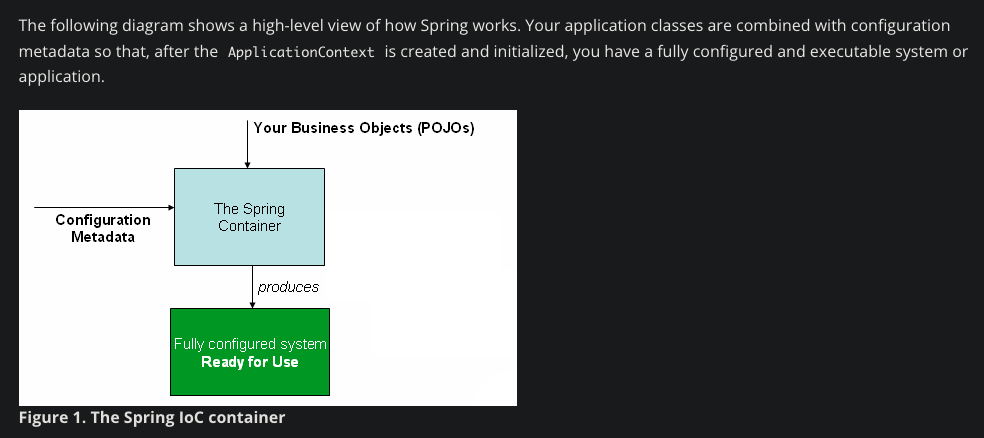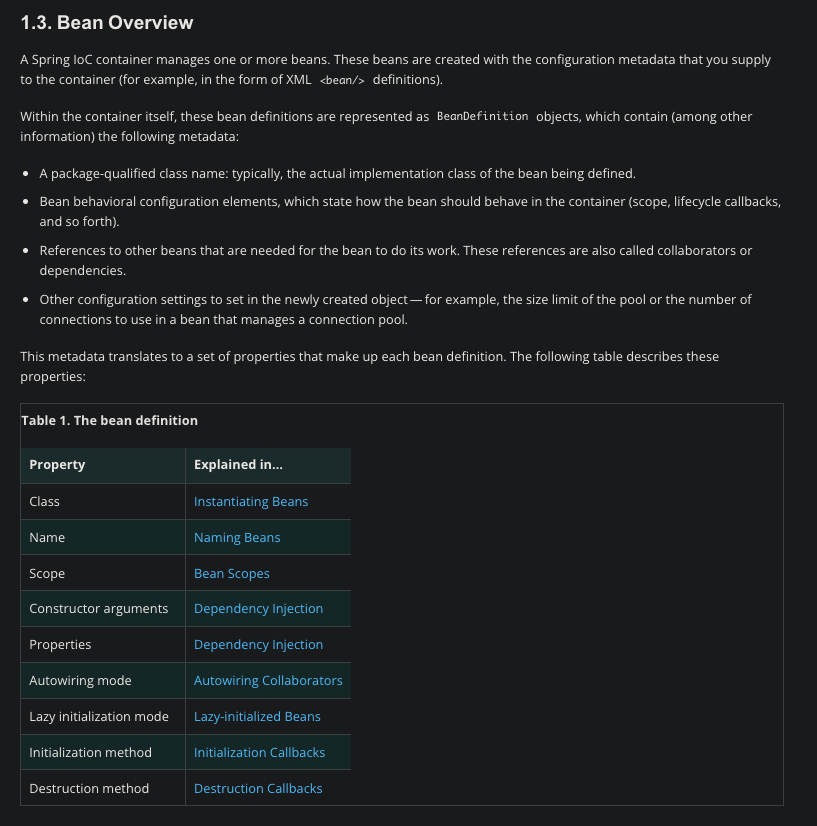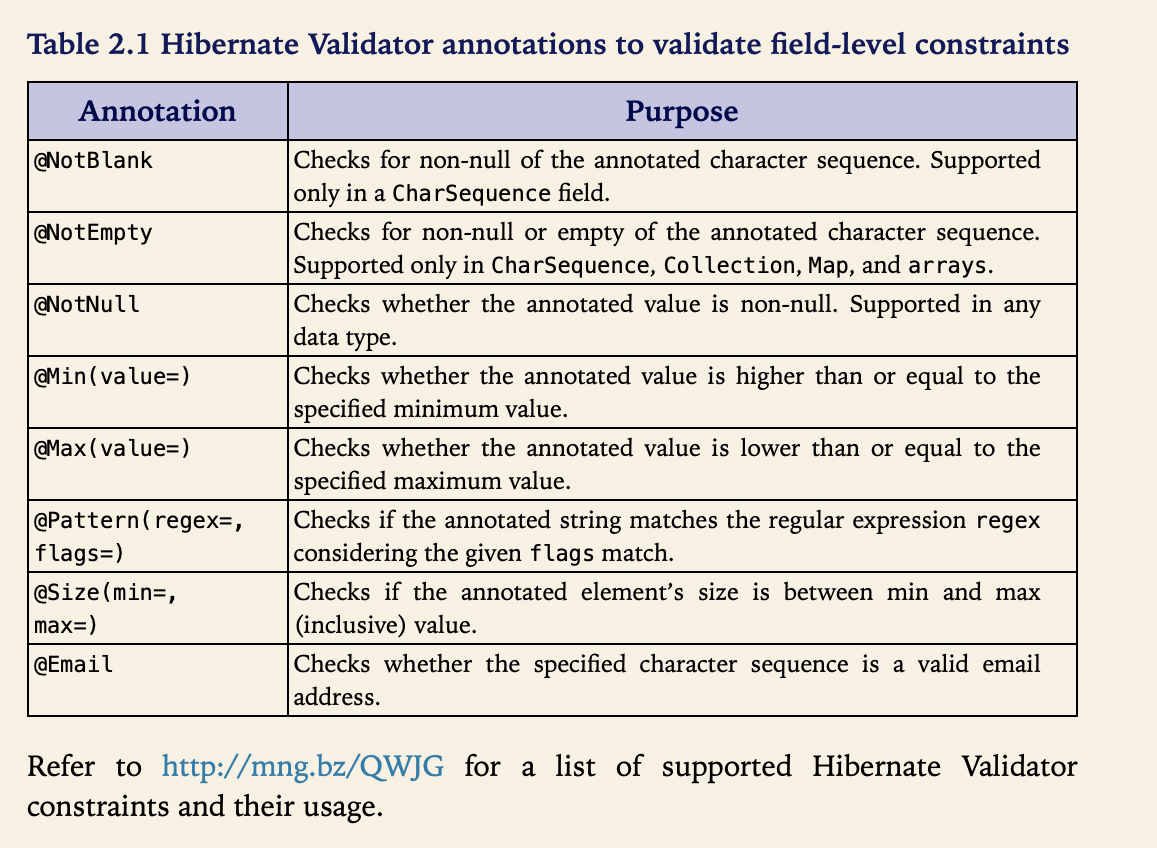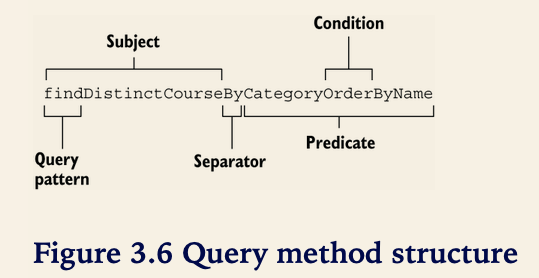Spring Boot - Web framework
Intro
This is my attempt for taking notes regarding the java spring boot framework. This a super brief summary. These notes are based on the Spring Boot in Practice book, but I also referenced another useful links from articles on the internet (thank to those people who give free good information).
General Concepts
What is a bean?
In Spring, the objects that form the backbone of your application and that are managed by the Spring IoC container are called beans. A bean is an object that is instantiated, assembled, and managed by a Spring IoC container (IoC means “Inversion of Control”) . Otherwise, a bean is simply one of many objects in your application. Beans, and the dependencies among them, are reflected in the configuration metadata used by a container.


Images and information were taken from the spring documentation website. For a more practical way to understand this please visit this link
What is Inversion of Control?
Simply put, Inversion of Control (IoC) is a process in which an object defines its dependencies without creating them. This object delegates the job of constructing such dependencies to an IoC container.
My own conclusion
Spring usa Algo que se llama aplication context para poder hacer la configuracion y la creacion de todo el seteo necesario para poder correr un proyecto de forma “automatizada” automatizada entre comillas porque pues tambien tienes que hacer uso de sus standares. En java un Bean no es mas que una clase que sigue un determinado standard, entre esos standares esta el usar variables privadas con sus respectivos getters and setters, un constructor vacio, etc. Pero tambien están los SpringBeans que siguen la misma que un Java Bean solo que necesita otras reglas o standards para poder considerarse SpringBean. De esa manera con el application context de Spring, Springboot sabe que beans existen y que dependencias tienen y así puede instanciar de manera automatica y tener un registro de las dependencias de la aplicacion de Spring. Obviamente esto es muy por encimita pero es lo que entendí hasta el momento. Pero en general para poder correr una aplicacion de SpringBoot se necesitan:
- Un ApplicationContext
- Un ApplicationConfig
- Los componentes o beans que van a ser utilizados.
Managing configuration
In Spring boot we can use several approaches to define the configuration of the program, we can set multiple environments(development, stage, uat, production, etc). The various approaches include property files, YAML files, environment variables, and command-line arguments.
Using the SpringApplication class
We can use a property file, look at this example, you will find a file called “properties” over resources folder.
So we are loading the properties instantiating the Properties class and then passing over the SpringApplication instance.
Using @PropertySource
We can also use an annotation called @PropertySource with an Environment object instance as you can see here.
Here we need to use the @Autowired annotation under the Environment instance variable and @Configuration to automatically make an instance of the Environment class and pass the path of the file that contains the environment variables as you can see the in the following snippet.
1: import org.springframework.beans.factory.annotation.Autowired; 2: import org.springframework.context.annotation.Configuration; 3: import org.springframework.context.annotation.PropertySource; 4: import org.springframework.core.env.Environment; 5: 6: @Configuration 7: @PropertySource("classpath:dbConfig.properties") 8: public class DbConfiguration { 9: 10: @Autowired 11: private Environment env; 12: 13: @Override 14: public String toString() { 15: return "User: "+env.getProperty("user") +", Password: "+env.getProperty("password"); 16: } 17: 18: }
Now obviously we need to have a dbConfig.properties file under resources folder located over the class path location. There we would have the environment variables defined as in UNIX are defined.
user=sa password=p@sswOrd
then we will be able to get the configuration as the following snippet shows on line 9:
1: @SpringBootApplication 2: public class SpringBootAppDemoApplication { 3: 4: private static final Logger log = LoggerFactory.getLogger(SpringBootAppDemoApplication.class); 5: 6: public static void main(String[] args) { 7: 8: ConfigurableApplicationContext applicationContext = SpringApplication.run(SpringBootAppDemoApplication.class, args); 9: DbConfiguration dbConfiguration = applicationContext.getBean(DbConfiguration.class); 10: log.info(dbConfiguration.toString()); 11: } 12: } 13:
Note: YAML files are not supported under this approach.
Config data file
Spring Boot lets you specify the application configuration properties in the application.properties or application.yml file. This is the most widely used approach to provide a configuration in a Spring Boot application. By default, the Spring Initializr-generated Spring Boot project includes an empty application.properties file.
By default, Spring Boot reads the application.properties or application.yml file from the following locations:
- The classpath root
- The classpath /config package
- The current directory
- The /config subdirectory in the current directory
- Immediate child directories of the /config sub directory
You can find the sample project here. To get the values of the environment variables you have to use an Environment
instance as we saw an above snippet on line 11.
OS Environment Variables
We can also refer to the operating system environment variables. Look at the below sample to know how to do it.
app.timeout=${APP_TIMEOUT}
The APP_TIMEOUT is an environment variable. In Linux you can define an environment variable as below line shows:
export APP_TIMEOUT=30
Then to get the values of the defined OS environment variables you can do the following:
1: package com.manning.sbip.ch02; 2: //imports 3: 4: @SpringBootApplication 5: public class SpringBootAppDemoApplication { 6: private static final Logger log = LoggerFactory.getLogger(SpringBootAppDemoApplication.class); 7: 8: public static void main(String[] args) { 9: ConfigurableApplicationContext applicationContext = SpringApplication.run(SpringBootAppDemoApplication.class, args); 10: Environment env = applicationContext.getBean(Environment.class); 11: log.info("Configured application timeout value: "+ env.getProperty("app.timeout")); 12: } 13: }
Creating custom properties with @ConfigurationProperties
There are two categories of spring boot properties or environment variables:
- built-in properties
- custom properties
Another way to define a custom property is through the @ConfiguratioProperties annotation. This technique is useful
when we would like to have properties type validations. To know more details, please refer to section 2.2.1 of the book.
You can see a sample of this technique looking at this sample project on GitHub provided by the author of the referenced book of this very brief resume.
Executing code on Spring Boot app startup
At times, you’ll need to execute custom code at Spring Boot application startup. For instance, you may want to execute a database initialization script before the application finishes its initialization or consume a REST service to load data for your application.
The CommandLineRunner and ApplicationRunner are two Spring Boot interfaces that provide a single run(..) method and are invoked just before a Spring Boot application finishes its initialization. These methods are invoked only once at the time of the Spring Boot application startup.
Both interfaces are almost the same. CommandLineRunner is the most used one, and there are three ways we can implement it.
- In the Spring Boot main class that implements the CommandLineRunner interface
- By providing the CommandLineRunner implementation as a bean definition using the @Bean annotation
- By providing the CommandLineRunner as a Spring Component using the @Component annotation
Look at the sample project here.
In a CommandLineRunner implementation you can also autowire any dependency using Spring’s dependency injection mechanism. Since a CommandLineRunner implementation runs when the Spring Boot application almost finishes its initialization, all bean definitions are available for autowire. Hence, you can autowire any bean dependency in your CommandLineRunner implementation.
For example, in the upcoming techniques when you’ll learn the Spring Data repository, you’ll see the use of the CourseRepository interface as a dependency on the CommandLineRunner implementation. The following listing shows an example.
@Bean public CommandLineRunner commandLineRunner(CourseRepository courseRepository) { return args -> { // lambda expression System.out.println("===== Course Details ====="); courseRepository.findAll().forEach(System.out::println); }; }
Configuring Logging
This subject will not have its resume at the moment. For more information please look at the book.
Using built-in Bean Validation annotations to validate business entity in a Spring Boot app

For more details please refer to the 2.3 section.
Also you can use third party libraries to do validations. Please refer to the project sample link on GitHub to check it out.
Chapter 3
Defining query methods
Spring Data JPA provides two ways to define custom query methods that can meet most of these custom requirements:
- Defining custom methods in the repository interfaces with specific naming patterns. Spring Data can internally parse these methods and generate the query from it.
- Defining custom methods and providing an SQL query that is directly used by the Spring Data to query the entities.
Spring Data uses the concept of a Subject and Predicate to parse the methods. It splits the method signature based on the By clause and treats the first half as the subject and the remaining part as the predicate. Thus, if you define a method named findDistinctCourseByCategoryOrderByName(), then the part DistinctCourse is the subject, and the CategoryOrderByName is the predicate. This is demonstrated in figure 3.6. Let’s use a technique to learn how you can define query methods to retrieve data from the database.

You can refer to this link to learn more about all the expressions or query methods you can use in the query method name.
If you want to see sample project please refer to this link.
Criteria API vs QueryDSL
In conclusion is better to use QueryDSL. These two different tools can be used as techniques to programmatically define queries in a type-safe manner. This because when using the @Query annotation we don’t have any type validation on queries, so if we have an error on any query definition the error will be throw on execution time, causing undesired results.
Which one should you use in your application? Well, both APIs are popular and widely used. Following are a few points to consider when deciding which API to use:
- The Criteria API is a native JPA library and, thus, has native support in JPA, whereas the QueryDSL is an open-source, third-party library.
- The Criteria API is criticized for its verbosity and complex nature of the API. You need to write more to even execute a simple query. The QueryDSL has a more approachable API due to the simpler and English-like API.
- Criteria API is only applicable for JPA. QueryDSL has integration with other data stores, such as MongoDB, Lucene, and JDO.
A sample project of the use QueryDSL can be found here: http://mng.bz/7Wn9.
Managing domain object relationships
In the relational database nomenclature, retrieving the required columns from different tables is known as projection. Spring Data lets you use projections either through interface-based projection or class-based projection. For more details please refer to the project.
CREATE TABLE authors ( id BIGINT NOT NULL, bio VARCHAR(255), name VARCHAR(255), PRIMARY KEY (id) ); CREATE TABLE authors_courses ( author_id BIGINT NOT NULL, course_id BIGINT NOT NULL, PRIMARY KEY (author_id, course_id) ); CREATE TABLE courses ( id BIGINT NOT NULL, category VARCHAR(255), description VARCHAR(255), name VARCHAR(255), rating INTEGER NOT NULL, PRIMARY KEY (id) ); ALTER TABLE authors_courses ADD CONSTRAINT course_id_fk FOREIGN KEY (course_id) REFERENCES courses (id); ALTER TABLE authors_courses ADD CONSTRAINT author_id_fk FOREIGN KEY (author_id) REFERENCES authors (id);
INSERT INTO COURSES(ID, NAME, CATEGORY, RATING, DESCRIPTION) VALUES(1, 'Rapid Spring Boot Application Development', 'Spring', 4, 'Spring Boot gives all the power of the Spring Framework without all of the complexity'); INSERT INTO COURSES(ID, NAME, CATEGORY, RATING, DESCRIPTION) VALUES(2, 'Getting Started with Spring Security DSL', 'Spring', 5, 'Learn Spring Security DSL in easy steps'); INSERT INTO COURSES(ID, NAME, CATEGORY, RATING, DESCRIPTION) VALUES(3, 'Getting Started with Spring Cloud Kubernetes', 'Python', 3, 'Master Spring Boot application deployment with Kubernetes'); INSERT INTO AUTHORS(ID, NAME, BIO) VALUES(1, 'John Doe', 'Author of several Spring Boot courses'); INSERT INTO AUTHORS(ID, NAME, BIO) VALUES(2, 'Steve Muller', 'Author of several popular Spring and Python courses'); INSERT INTO AUTHORS_COURSES(AUTHOR_ID, COURSE_ID) VALUES(1, 1); INSERT INTO AUTHORS_COURSES(AUTHOR_ID, COURSE_ID) VALUES(1, 2); INSERT INTO AUTHORS_COURSES(AUTHOR_ID, COURSE_ID) VALUES(2, 1); INSERT INTO AUTHORS_COURSES(AUTHOR_ID, COURSE_ID) VALUES(2, 2); INSERT INTO AUTHORS_COURSES(AUTHOR_ID, COURSE_ID) VALUES(2, 3);
Containerizing an Spring Boot app
This article on the docker official website is really helpful to get the better tips to containerize an Spring Boot code.
Extras
If we would like to connect to a database such as Postgresql, we can look at the repository I created and uploaded on GitHub here. Also here is a file that contains a sample of an sql file to create a database and tables on it and insert sample data from the Postgresql website.
Some informal videos I recorded for reference.